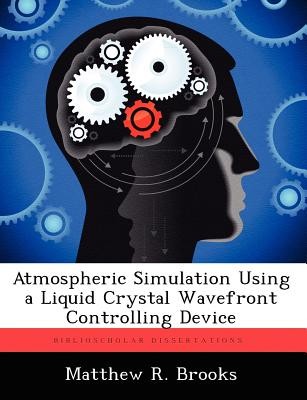
- We will send in 10–14 business days.
- Author: Matthew R Brooks
- Publisher: BiblioScholar
- ISBN-10: 1249584795
- ISBN-13: 9781249584797
- Format: 18.9 x 24.6 x 0.5 cm, softcover
- Language: English
- SAVE -10% with code: EXTRA
Atmospheric Simulation Using a Liquid Crystal Wavefront Controlling Device (e-book) (used book) | bookbook.eu
Reviews
Description
Test and evaluation of laser warning devices is important due to the increased use of laser devices in aerial applications. In this thesis, an atmospheric aberrating system is developed to enable in lab testing of laser warning devices. This system employs laser light at 632.8 nm from a Helium Neon source and a spatial light modulator(SLM) to cause phase changes using a birefringent liquid crystal material. Before the system can be used, the SLM phase response must be quantified to ensure proper manipulation of index of refraction. Additionally, diffraction from the SLM and real world system scaling are addressed. Once completed, the atmospheric simulator is demonstrated and verified. Control of the SLM is achieved by loading 256 level bitmaps which dictate the desired index of refraction changes(called phase screens). Phase screens are created using a Fourier series technique applied to an atmospheric model in the form of a power spectrum. Five laser propagation scenarios are created, each with a set of screens describing turbulence for a particular case. Outgoing radiation from the SLM is then measured using a CCD target board for intensity and a Shack Hartmann wave front sensor for phase.Comparing system output phase statistics to atmospheric theory reveals a mode rate correlation in all turbulence cases indicating desired performance. Intensity statistics are compared to the log normal distribution governed by the weak fluctuation regime. An error analysis reveals that strong turbulence data matches theory but that weak turbulence data is inconclusive due to measurement precision issues. As an additional check on performance, a wave optics computer simulation is created analogous to the lab bench design. Phase and intensity data affirm lab bench results so that the aberrating SLM system can be operated confidently.
EXTRA 10 % discount with code: EXTRA
The promotion ends in 18d.08:07:00
The discount code is valid when purchasing from 10 €. Discounts do not stack.
- Author: Matthew R Brooks
- Publisher: BiblioScholar
- ISBN-10: 1249584795
- ISBN-13: 9781249584797
- Format: 18.9 x 24.6 x 0.5 cm, softcover
- Language: English English
Test and evaluation of laser warning devices is important due to the increased use of laser devices in aerial applications. In this thesis, an atmospheric aberrating system is developed to enable in lab testing of laser warning devices. This system employs laser light at 632.8 nm from a Helium Neon source and a spatial light modulator(SLM) to cause phase changes using a birefringent liquid crystal material. Before the system can be used, the SLM phase response must be quantified to ensure proper manipulation of index of refraction. Additionally, diffraction from the SLM and real world system scaling are addressed. Once completed, the atmospheric simulator is demonstrated and verified. Control of the SLM is achieved by loading 256 level bitmaps which dictate the desired index of refraction changes(called phase screens). Phase screens are created using a Fourier series technique applied to an atmospheric model in the form of a power spectrum. Five laser propagation scenarios are created, each with a set of screens describing turbulence for a particular case. Outgoing radiation from the SLM is then measured using a CCD target board for intensity and a Shack Hartmann wave front sensor for phase.Comparing system output phase statistics to atmospheric theory reveals a mode rate correlation in all turbulence cases indicating desired performance. Intensity statistics are compared to the log normal distribution governed by the weak fluctuation regime. An error analysis reveals that strong turbulence data matches theory but that weak turbulence data is inconclusive due to measurement precision issues. As an additional check on performance, a wave optics computer simulation is created analogous to the lab bench design. Phase and intensity data affirm lab bench results so that the aberrating SLM system can be operated confidently.


Reviews